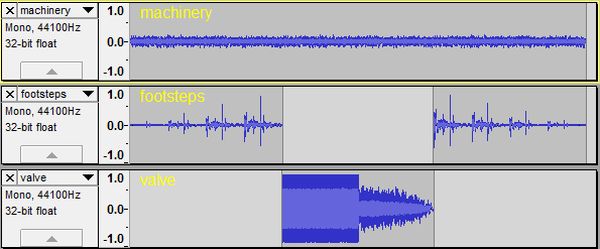Audio: low pass filter (0:06)

low pass filter plays a sound effect. It simulates the sound of someone in a room with machinery approaching a steam valve, opening it, closing it, then walking away. The low pass filter figure, the waveform, shows that the effect is achieved by layering (mixing) three sounds:
Low pass filtering passes frequencies below a cutoff frequency and reduces the amplitude of frequencies above.
Low pass filtering is the most common filtering effect. It is often used to eliminate unwanted high frequency noise in a sound.
Low pass filtering excels at producing muffled sound effects. This simulates the behaviour of sound in real life. As sound passes through a surface or a medium it loses energy. The surface or medium acts as a low pass filter, it absorbs high frequencies and passes low frequencies.
Acoustic absorption is the process by which a surface absorbs sound. Part of the absorbed sound is transformed into heat and the remainder is transmitted through the surface. All mediums and surfaces are sound absorbers to a greater or lesser extent. Air is porous and absorbs relatively little sound. Walls are relatively porous compared with water and other denser mediums which absorb sound. People, wool and snow are significant absorbers of sound.
Imagine standing outside a door, for example, listening to music, then opening the door. To create this effect, low pass filter the music, so that only the low frequency sound is heard. Then remove the filter to simulate opening the door.